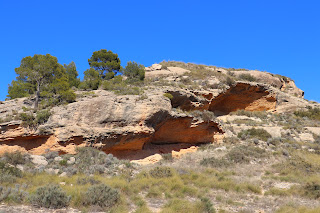Monte Arabí is a natural park, about 20 kms out of Yecla, almost into Castilla la Mancha. It has some nice looking, rounded and very young, geologically speaking, Miocene rocks (10-12 million years old) and a bunch of trees and Mediterranean scrub. It's one of those places to wear the trousers you bought from Decathlon and to load a bottle of water, and maybe a bocadillo wrapped in silver paper, in your backpack. Mobile phones are a bit lost in the park - not much of a signal.

I have to admit to not being a fan of most of the walks in this area. Ooh, look, a pine tree and some esparto grass, oh, and there's another pine tree. As Ivor Cutler said of the Scottish countryside - “We were soon well acquainted with the thistle, there are many thistles in Scotland”. I like Monte Arabí though because it's one of those places that has a long history of human settlement and I like the idea of continuity. The first time I was there, in 2011, I clambered up the hillside and peered through the iron grille that protected the pinturas rupestres, the prehistoric, abstract, wall paintings below a rocky overhang which shelters the cliff face. Later, in 2019, we went on an organised tour with the Yecla Tourist Office. The guide had the key for the padlock of the big steel fence behind which there were more prehistoric wall paintings - much more figurative paintings with people and animals. The same guide told us about the wall paintings that I'd seen on my earlier visit and about some petroglyphs in another part of the park. As we didn't see them that day, I went back a couple of weeks later to find them.
Petroglyphs, are rock carvings. Possibly just a Bronze Age version of “Kilroy was here” possibly something with deeper significance. I didn't find them in 2019 but I did end up on the top of Aribelejo, which is where the only water to be found within the park is and where there was once a Bronze Age settlement. Just while we're on petroglyphs there are some nice ones up on La Centenera Hill in Pinoso.
This visit we started with La Cueva de la Horadada, a collapsed cavern that has left a big hole through solid rock. I kept mumbling on to my partner about how good the wall paintings were and how close you could get but, when we got there, things had changed. There is now a huge steel fence running around the cliff face and the unhindered growth of the vegetation behind the fence means you can no longer see the paintings. I'm all for protecting the site but surely the powers that be could have found a way to protect the paintings and still allow them to be seen? The paintings are only of any interest to people - passing rabbits, wild boar and hedgehogs will be happily oblivious to the paintings importance in human development. At least we found the petroglyphs this time. In fact they were dead easy to find, just beside the track. and made easier by the full explanation we got from the ranger in the Punto de Información in the old Casa de Guarda.






Comments
Post a Comment